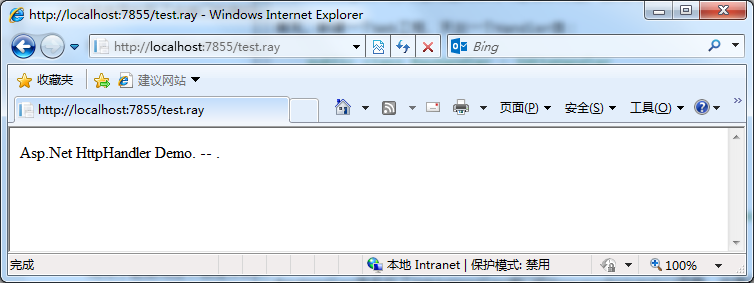在Web應用開發或介面開發時,處理請求介面IHttpHandler隨處可見,那麼我們這次來簡單聊一下這個介面。 ASP.NET響應Http請求時常用的兩個處理介面,分別是IHttpHandler和IHttpModule。 1、IHttpHandler 一般用來處理一類特定的請求,比如對每個*.asp ...
在Web應用開發或介面開發時,處理請求介面IHttpHandler隨處可見,那麼我們這次來簡單聊一下這個介面。
ASP.NET響應Http請求時常用的兩個處理介面,分別是IHttpHandler和IHttpModule。
1、IHttpHandler
一般用來處理一類特定的請求,比如對每個*.asp, *.aspx文件的分別處理。
2、IHttpModule
通常用來處理所以請求共同需要的操作,比如對所以請求頁面進行某些相同的檢查功能。
我們先來看一下IIS伺服器在相應Http請求時的處理步驟。

請求到達之後,實現經過HttpModule處理之後再調用HttpHandler的ProcessRequest()方法進行具體相應的。因此,也不難理解為什麼說在HttpModule中做一些對所有請求通用的檢查操作,而將特定類請求的處理放在HttpHandler類中。
一、IHttpHandler
首先我們來看一下IHttpHandler介面設計。
IHttpHandler介面只有兩個成員:
public interface IHttpHandler { bool IsReusable { get; } void ProcessRequest(HttpContext context); }
1、IsReusable:標識該HttpHandler對象能否被其他實例使用,一般我們將其置為True。
2、ProcessRequest():具體響應請求方法,我們只要將具體的業務邏輯操作放在這裡即可。
實踐:
新建一個Web工程,添加一個Handler類:
public class RayHandler : IHttpHandler { public bool IsReusable { get { return true; } } public void ProcessRequest(HttpContext context) { context.Response.Write("Asp.Net HttpHandler Demo. -- ."); } }
然後,我們需要在Web.config文件中添加以下配置:
<handlers> <add name="test" path="*.ray" verb="*" type="WebApplication2.RayHandler,WebApplication2"/> </handlers>
對config文件中的幾個屬性做一下說明:
1、path:表示URL匹配,如*.ray這表示該Handler會響應所以以".ray"結尾的URL請求。
2、verb:表示請求方法,如Get/Post,使用*則表示所以匹配所有。
3、type:指示Handler類的類型,上面的config文件中,WebApplication2.RayHandler是類名,WebApplication2是指Bin目錄下該該程式集的名稱(不帶.dll尾碼)。
啟動站點,輸入以".ray"結尾的URL,可以看到如下結果:

問題:
有時候我們可能需要處理多種不同的尾碼,一個尾碼對應一個Handler類,這時我們的Web.config文件看起來就是這樣了:
<handlers> <add name="test" path="*.ray" verb="*" type="WebApplication2.RayHandler,WebApplication2"/> <add name="test1" path="*.rss" verb="*" type="WebApplication2.RssHandler,WebApplication2"/> </handlers>
如果我們有很多的HttpHandler實現類,那麼我們的Web.config文件配置勢必會顯得很冗長。
解決問題:
為瞭解決以上問題,需要使用IHttpHandlerFactory。一看這個介面的名字,猜測是以工廠模式實現的。首先我們來看一下他的介面構成:
IHttpHandlerFactory
public interface IHttpHandlerFactory{ IHttpHandler GetHandler(HttpContext context, string requestType, string url, string pathTranslated); void ReleaseHandler(IHttpHandler handler); }
1、GetHandler(): 返回一個實現了IHttpHandler介面的實例。
2、ReleaseHandler():使得Factory可以重覆使用一個已經存在Handler實例。
以上述ray,rss請求為例,實現Factory類:
public class HandlerFactory : IHttpHandlerFactory{ public IHttpHandler GetHandler(HttpContext context, string requestType, string url, string pathTranslated){ IHttpHandler handler = null; string path = context.Request.PhysicalPath; switch(Path.GetExtension(path)){ case ".ray": handler = new RayHandler(); break; case ".rss": handler = new RssHandler(); break; default: break; } return handler; } public void ReleaseHandler(IHttpHandler handler){ //void } }
這時,在Web.config中的配置如下:
<handlers> <add name="test1" path="*.ray,*.rss" verb="*" type="WebApplication2.FactoryHandler,WebApplication2"/> </handlers>
使用了IHttpHandlerFactory,那麼我們的config文件的配置相對就簡化了很多。
問題:
如果程式後續需要增加對新尾碼的處理方法,就需要修改GetHandler()中的Switch語句,可能引發錯誤或帶來其他安全隱患,這樣做也違反了設計原則中的開放封閉原則。那麼,如何才能夠實現在後續擴展時,保持HandlerFactory類不變呢?
解決問題:
答案肯定是可以的。 熟悉設計模式的應該明白這裡是一個簡單工廠模式,要實現前面的功能我們用叫高級點的設計模式是可以實現的。
而在這裡,我們還可以用C#語言的語言特性--反射。 通過C#的反射機制,我們根據URL的尾碼來反射獲取對應的Hanlder類型,只要我們將URL的尾碼名跟Handler的類名約定一下對應關係即可。具體實現方式不在說明。



